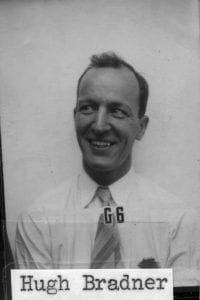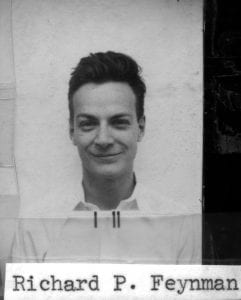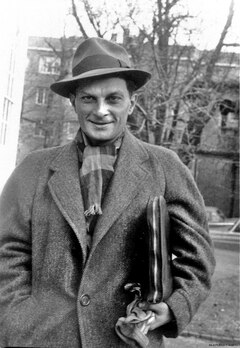
PHYSICIST LUIS ALVAREZ IS SEEN IS HIS LABORATORY PREPARING TO EVACUATE A GEIGER COUNTER. IMAGE © BETTMANN/CORBIS
Luis Alvarez and his life as “an American experimental physicist, inventor, and professor who was awarded the Nobel Prize in Physics in 1968” was fascinating to research. He had published 22 patents, gotten involved with the Manhattan project during WWII as well as some of the technology helping the allies during the war. Listening to Alvarez’s life story gave me inspiration in many different ways.
Luis Alvarez was born on June 13th, 1911. His parents were Walter C. Alvarez and Harriet Smyth Alvarez. His father was a physician who conducted research. He became known as the American family doctor pretty soon on the newspaper, and had a great deal of influence on Alvarez. In Alvarez’s own words, he noted that “My father advised me to sit every few months in my reading chair for an entire evening, close my eyes, and try to think of new problems to solve. I took his advice very seriously and have been glad ever since I did.”
After attending University of Chicago for three years, Alvarez decided that chemistry did not suit him well enough for his declared major. He decided to switch over to physics after encountering the class “Advanced Experimental Physics Light”, and had to take twelve physics classes in five quarters. He then graduated with a BS in physics in 1932, MS in 1934, and a PhD in 1936. However, Alvarez concluded that his academics did not prepare him well enough for what was to come.
Alvarez achieved major discoveries, especially with cosmic rays and minuscule particles. He co-discovered the East-West effect in cosmic rays, which allowed scientists to conclude that the cosmic rays were charged with positive particles when the popular opinion at the time was quite the opposite. Alvarez also gave the first practical demonstration of k-capture in 1937, showing that atoms could decay when they absorb an electron from the lowest electron layer called the k-layer. This idea was theorized before, but Alvarez was the first one to prove it by demonstration.
To prepare for WWII wars, Alvarez left California to head towards Cambridge in November 11, 1940. While staying in MIT, he developed the radar technology that was used to track down German U-boats. When the Germans also installed some radar technology on their boats, Alvarez came up with an enhanced Vixen system which let the ally planes fool their radar technology. The Vixen system made the planes seem like they were moving away from the boats on radar, which in reality was the opposite. Alvarez, using similar methods, also created a safer system for the allies to guide their planes in during harsh weather. After a long trial and error stage, the system was able to let the crew on ground measure the exact angle the planes were in with the ground, and give instructions to bring them down securely.
In 1943, Alvarez left MIT and joined the Manhattan project. Before joining the Los Alamos Lab to work on the steering committee for the nuclear bombs, he worked in Chicago with some others to develop a chain reaction that has to set off in nuclear bombs. Most of Alvarez’s work in the Los Alamos lab was on the plutonium bombs, although he did test both the uranium and plutonium bombs. His main job was to create a detonator for the bombs. The first bomb, created for testing purpose, that they worked on was named “The Gadget”. It was an implosion-design plutonium bomb. The Gadget was set off in what is now known as Trinity Site. Once the test was finished, Alvarez and other scientists moved to the islands of Tinian, where they prepared the bombs and the bombers for their eventual missions.
On August 6, 1945, Alvarez rode on B-29 aircraft with the bombers. Unlike others, Alvarez did not wear a parachute. He, in his self-written biography, stated that if the plane was to be shot down, he did not want to be captured alive. Alvarez witnessed the Little Boy being dropped on Hiroshima, and felt that he had to write a letter to his four year old son. These are his exact words.
“What regrets I have about being a party to killing and maiming thousands of Japanese civilians this morning are tempered with the hope that this terrible weapon we have created may bring the countries of the world together and prevent further wars. Alfred Nobel thought that his invention of high explosives would have that effect by making wars too terrible. But unfortunately it had just the opposite reaction. Our new destructive force is so many times worse that it may realize Nobel’s dream.”
The Fat Man was dropped on August 9, 1945. Alvarez boarded not on the bomber plane this time, but on a small plane next to the B-29 Bockscar with many other physicists. Right before the bomb was dropped, Alvarez and others sent down a canister holding telemetry devices and a letter. In the letter, addressed to Japanese nuclear physicist Ryokichi Sagane—a man Alvarez had worked with before in Berkeley, Alvarez and the others pleaded Sagane to use his influence to reach his leaders and generals to stop the war. They had noted how strong the nuclear weapon was, and that Japanese cities would be totally annihilated if the war continued this way.
After the peace treaty was signed, Alvarez, like many other scientists who worked on the nuclear bomb, was horrified of the results. There were many controversial talks of if the Fat Man was really necessary, and Alvarez believed it indeed was, rather than the more popular contrary belief. He believed that because it did not take long for them to use the second weapon, it scared other countries enough to surrender into making peace. He also believed that Nagasaki and Hiroshima would have been depleted by other measures, if not by nuclear bombs.
In his later years, Alvarez focused his efforts on high energy atomic research. He met with Donald Glaser, the founder of the Bubble Chamber, to study the device. Bubble Chamber was a device that allowed the scientists to track the movements of the particles inside a glass tube by the bubbles they created while moving around. When Alvarez was starting out with his studies for particles, he started with a Bubble Chamber about an inch wide. Later, he was working with glass tubes that measured seventy-two inches. He also switched the fluid inside the tube to hydrogen. Since hydrogen is 2500 degrees below Celsius, as the particles moved around, they boiled hydrogen to make bubbles. Using this technology, Alvarez discovered a lot of elementary particles, including the short-lived resonant state particles. Alvarez won a Nobel Prize for his discoveries of elementary particles, and will be remembered most for making a lot of particle physics possible.
While Alvarez was truly a genius man, death had taken him on September 1, 1988 by cancer. Alvarez had left many discoveries and advancements in technology for us to develop more, and he shall be admired for all his hard work.
I believe that the legacy that Alvarez left is not only his amazing work, but his respect towards science is honorable as well. Richard Muller, who was a PhD student working under Alvarez, wrote a book named Nemesis, the Death Star, which had a chapter and short references in the beginning and throughout the book about his experiences with Alvarez. Muller and Alvarez seemed to have an argument on whose opinion on an academic paper was right. During the heated discussion, Muller argued that there could be a model to disapprove Alvarez’s argument, to which Alvarez described the thought process “no-think,” only because it was purely hypothetical to his eyes. When Muller did come up with a model that was built on half-sincerity, Alvarez quickly retracted his arguments and took it seriously enough to examine if there are any flaws. He later admitted that he would have had an answer had Muller proposed another model, but the model that Muller came up with surprised him and that he hadn’t been considering the chance at all. The air in the room seemed to chill, and they started to think seriously about the chances of the model being a reality. Alvarez was quick to retract his words and give his honest opinions on what he thought; he was willing to lose a debate if it meant for the correctness of science.
Aside from his many accomplishments and other thoughts about Alvarez, I think this quote of him talking about one of his high school stories displays his character the best:
“In Rochester, a friend and I used to climb the buildings under construction, usually by sneaking past the guards in the middle of the night. We climbed the three hundred foot clinic tower when it was only a skeleton of steel beams. We explored the power house and scaled the inside of its 200 foot brake smokestack. I mentioned these escapades not to brag about being a scofflaw, but only because I’m convinced that it controlled disrespect for society is essential to a scientist. All the good experimental physicist I have known have had an intense curiosity that no keep-out sign could mute. “
Bibliography
Wilson, T. V., & Frey, H. (2013, September 23). Luis W. Alvarez, Pt. 1 [Audio blog post]. Retrieved December 23, 2017, from https://www.missedinhistory.com/podcasts/luis-w-alvarez-pt-1.html
Wilson, T. V., & Frey, H. (2013, September 23). Luis W. Alvarez, Pt. 2 [Audio blog post]. Retrieved December 23, 2017, from https://www.missedinhistory.com/podcasts/luis-w-alvarez-pt-2.html
The Editors of Encyclopædia Britannica. (2017, April 10). Luis Alvarez. Retrieved December 23, 2017, from http://www.britannica.com/biography/Luis-Alvarez
Muller, R. (1998). Nemesis, the death star. New York: Weidenfeld & Nicolson.
Written by Romeo.
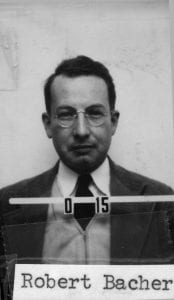


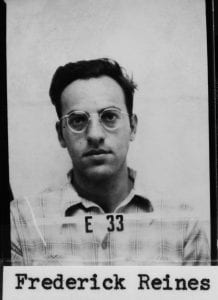 By: evan West
By: evan West